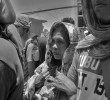(Second of a three-part column)
In the history of the Moro people, the Kirams were a picture of a royalty who gave in to the colonials. Sabah was a gift given by the Sultanate of Brunei to the Sultanate of Sulu, because of its help in quelling a rebellion against the Brunei sultanate in 1658. The Sulu Sultanate then leased North Borneo to British North Borneo Company in 1878 in exchange of 5,300 Mexican pesos. Britain would then annex Sabah during colonization until 1946 and the new Federated Malaysia included it as part of its territory in 1963.
By AMIRA ALI LIDASAN
Davao Today
It was a complete turn-around. The elder Kiram is helping the government wash their hands off the carnage in Sabah. President Aquino offers talks of disengagement of forces to the Kirams, a way of salvaging itself from the quagmire of criticism at abandoning the victims in Lahad Datu and doing nothing as the Malaysian government commitS human rights violations against the Filipino people in Sabah. Through the intercession of Roxas, Sultan Esmael Kiram became the spokesperson of the sultanate family, trying to suppress Princess Jacel’s ferocious criticisms, which, according to her uncle, is not helping the Kiram sultanate in negotiating for the resolution of the standoff in Sabah.
This is now the kind of Kiram that the Moro people knew, the sultanate who negotiated with the American colonial government which led to the further loss of his land and people, first North Borneo in the hand of the British colonial government in 1878 and then Sulu and Palawan in the Kiram-Bates Treaty.
In the history of the Moro people, the Kirams were a picture of a royalty who gave in to the colonials. Sabah was a gift given by the Sultanate of Brunei to the Sultanate of Sulu, because of its help in quelling a rebellion against the Brunei sultanate in 1658. The Sulu Sultanate then leased North Borneo to British North Borneo Company in 1878 in exchange of 5,300 Mexican pesos. Britain would then annex Sabah during colonization until 1946 and the new Federated Malaysia included it as part of its territory in 1963.
During Spanish colonialism, Spain laid claim to the rest of the Sulu Sultanates territory by abrogating Sulu and Palawan as part of her territory. The small Spanish garrisons in Zamboanga, Basilan and Siasi in Sulu are testament to Spanish colonialism that was able to penetrate Mindanao either through the Spanish Treaty of Peace with the Sultan Jamal ul-Azam.
The Kirams would be entrenched in the Moro history as the Sultanate who was responsible for losing the rest of the sultanate by signing the 1898 Kiram-Bates Treaty, as part of the pacification campaign of the American colonial government which completed their territorial claim over the whole archipelago.
Through its emissary Brig. Gen. John Bates, the American colonial government made to sign the Sulu Sultanate to recognize U.S. sovereignty over Sulu and its dependencies in exchange of Sultan Jamal ul-Kiram II and his datus (tribal chiefs) receiving monthly allowance of USD 250.
In letter, there was a mutual respect between the U.S. government and the Sultanate of Sulu, recognition of Moro autonomy and non-interference with Moro religion and customs. Soon after, the American colonial administration started disallowing and confiscating guns of the Sultan’s army and started to impose PHP 2.00 taxes on the Tausugs prompting rebellion from the other datus.
It was Panglima Hassan, the commander of Luuk, Sulu, who defied Sultan Kiram’s order of recognizing US sovereignty over Sulu who led the attack against the military garrisons of the American colonial government and even against the pro-American datus of Sultan Kiram.
The Battle in Bud Dajo in March 4, 1906 claimed more than a thousand of Tausug women and children, the people of Sultan Kiram II. Another pacification campaign led by General Leonard Wood and Pershing that killed many of the Sultan’s people was the Battle of Bud Bagsak in 1913.
American occupation in the country was one of the bloodiest in the history of American colonial occupation. It even made in the pages of Vladimir Lenin’s Imperialism, the Last Stage of Capitalism.
If Sultan Kudarat is known in history as the valiant sultan who fought Spanish colonialism, Sultan Kiram II is the picture of a sultanate who was not able to defend his people and who was stripped of his identity as he signed Carpenter Agreement with then US Gov. Gen. Frank Carpenter relinquishing his sovereignty to the American colonial government. After his death, the Philippine Commonwealth under Manuel L. Quezon refused to recognize the sultans succeeding him.
But it was a woman, Princess Hadja Tarhata Kiram, who will figure prominently in current Moro stories. A local magazine was able to interview here before she died, leaving a very good story that has redefined the sultanate’s image. She was the niece of Sultan Kiram II and was made to study in the US in 1920 as the first woma pensionado.
When she returned home, she embraced her native ways and married Datu Tahil, Tausug leader who was a product of the Battle of Bud Bagsak and who led the Moro revolt in 1927 against imposition of taxes and prohibition of carrying weapons. In the end, she would also be part of the Sulu Sultan heirs who gave up propriety rights of Sabah to then President Marcos.
The story and legacy of the Kirams would be eclipsed temporarily as the new generation of Moro youth and professionals articulate the right to self-determination of the Moro people in the 1960’s. Over the years, the sultanate’s claim over Sabah will continue to make its presence felt in the struggle.
As I have said in a national newspaper, for the Moro people, the Sulu Sultanate and their claim over Sabah is an unfinished business, as well as the abrogation of the MinSuPala (Mindanao, Sulu, Palawan) territories to the Philippine territorial integrity. But while as Moro people we can claim MinSuPala, only the Sultan’s can lay claim to North Borneo.
The 13 ethno-linguistic group that would comprise the Moro people struggling for right to self-determination involved not only the Tausugs or the people under the Sulu Sultanate, but all the tribes who fought the Spanish and American colonialism, within or outside of the Sulu Sultanate, Maguindanao Sultanate and the Pat A Pangampong of Lanao. They were united by their struggle against colonials, even if they did not have formal and permanent alliances, or fought side by side. Like the rest of the Filipino people, the Moro people’s identity was defined by their fight against colonialism.
In the 1970’s, Sabah is associated to the Jabiddah Massacre, the incident which sparked the flame of anger against the Marcos government and start of the struggle of the new generation of Moro people to right to self-determination. President Ferdinand Marcos created a covert operation called Operation Merdeka which recruited and trained military Tausugs to bring chaos to Sabah by staging operations which will push the Filipino people residing in Sabah to assert separation from the Malaysian government.
When the men refused, they were killed and only one survived to tell the tale.
Senator Benigno Aquino, Jr. helped exposed the issue and this became one of his ammunition against President Marcos. This also fuelled mass protest of the Muslim students and professionals in Manila and those studying abroad, and attracted sympathy from all over the Muslim world.
Until now, the heirs of the Marcos and Aquino would still have a contradicting stand over the recent issue involving the uprising in Sabah. While Noynoy Aquino is peeved about the Kiram Sultanate, Bongbong Marcos issued sympathy statement and even demands Aquino to stand with the Moro people.
In the beginnings of the Moro National Liberation Front (MNLF), seldom have we heard Professor Nur Misuari, Ustadz Hashim Salamat and the other leaders recognize the Sulu Sultanate’s claim over Sabah. This is because former Prime Minister Tuan Tunku Abdul Rahman was helping the MNLF by making Sabah their staging ground for military training and also providing them of armaments.
In the shaping of the concept of the Moro people’s right to self-determination and the armed struggle waged by the MNLF and the Moro Islamic Liberation Front (MILF), I have not seen nor heard the Kiram sultanate involved in the struggle. The heirs of Sulu Sultanate were known to mingle with the elite people in Manila, or as in the previous election, be part of a national political party.
The right to self-determination of the Moro people is directed against the Philippine government whose historical neglect and injustice towards the Moro national minorities justifies their separation, through autonomy and secession, against an oppressive state.
In the 70’s until 80’s, the Moro people were massacred by the Marcos administration in the series of annihilation campaign against the MNLF. Until now, the Tausugs could not recover from the destructive Burning of Jolo by the Marcos administration in 1974.
In the 90’s up to the present, the Moro people are tagged as terrorists and forced out of their lands. The Tausugs were displaced from Sulu and found home in Zamboanga, Basilan, Tawi-Tawi and even Sabah, Malaysia.
Misuari’s assertion of the Moro people’s territory through the Bangsmoro Republik, however, involved only MinSuPala (Mindanao, Sulu, Palawan), excluding Sabah. There was no mention of the Sabah claim in both 1976 Tripoli Agreement and in the 1996 Final Peace Agreement. There was also no mention of the Sabah claim in the GRP-MILF Memorandum of Ancestral Domain in 2008 and the GPH-MILF Framework Agreement on Bangsamoro in 2012.
But we cannot ignore that the Sulu Sultanate have relatives within the MNLF and MILF, especially those residing in Sulu and Sabah, Malaysia. Hence, it is difficult for these revolutionary groups to ignore the sultanate and its claim over Sabah. And with the almost 80,000 Filipinos (mostly Moro) living in Sabah, all the more that the MNLF and MILF cannot ignore the calls for help of the Moro migrants in Malaysia.
First part: The princess of her people
Third part: A bitter pill for Moro migrant workers
Amira Ali Lidasan is an Iranun and hails from a prominent Moro clan in Maguindanao. She is an observer of Moro politics and an activist. Write to Amira at amira.lidasan@gmail.com.

![[STANDPOINT] Illegal drugs and the NIMBY mindset](https://davaotoday.com/wp-content/uploads/2016/09/Mags-Maglana_UPMIN-Sept.-20-110x100.jpg)








